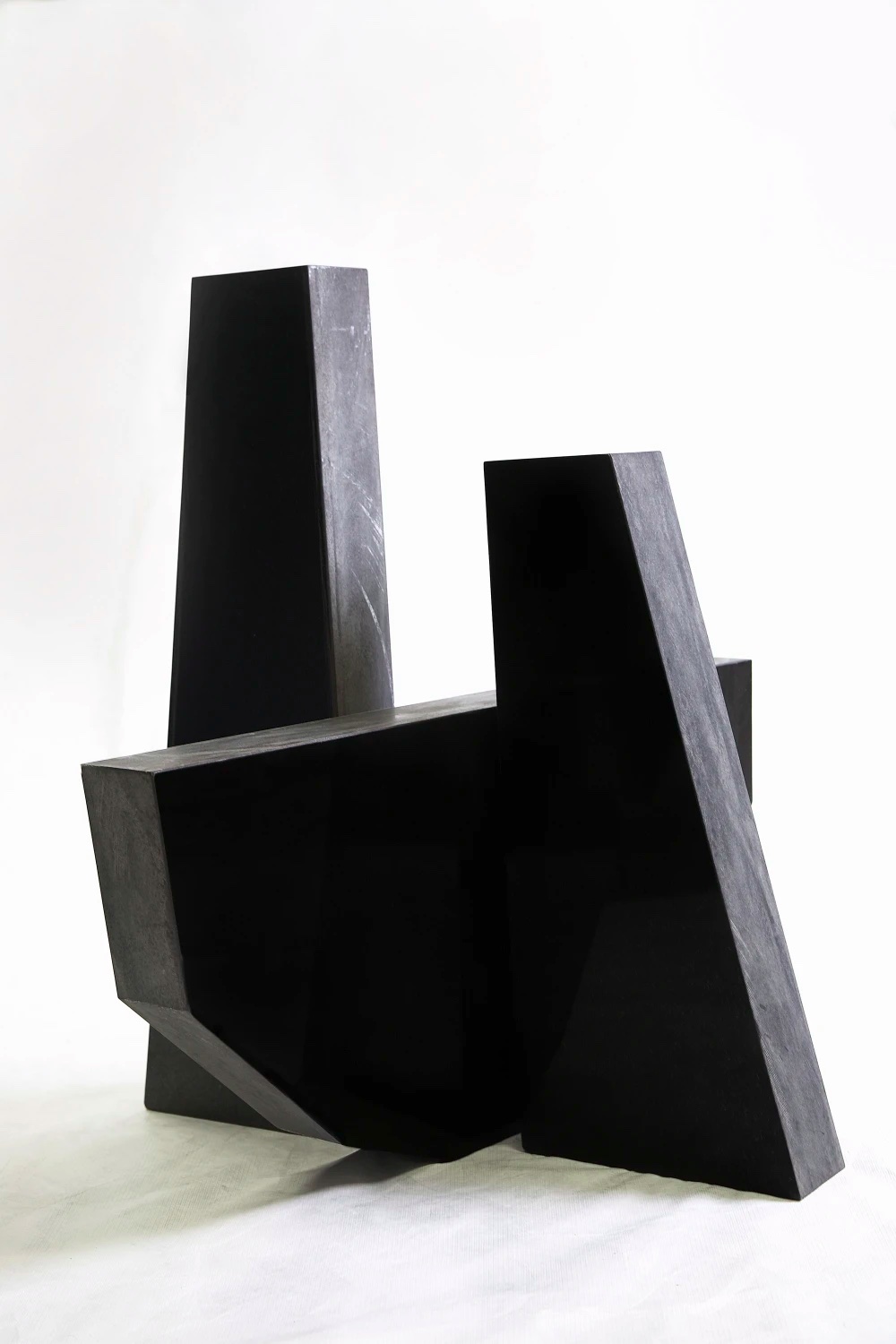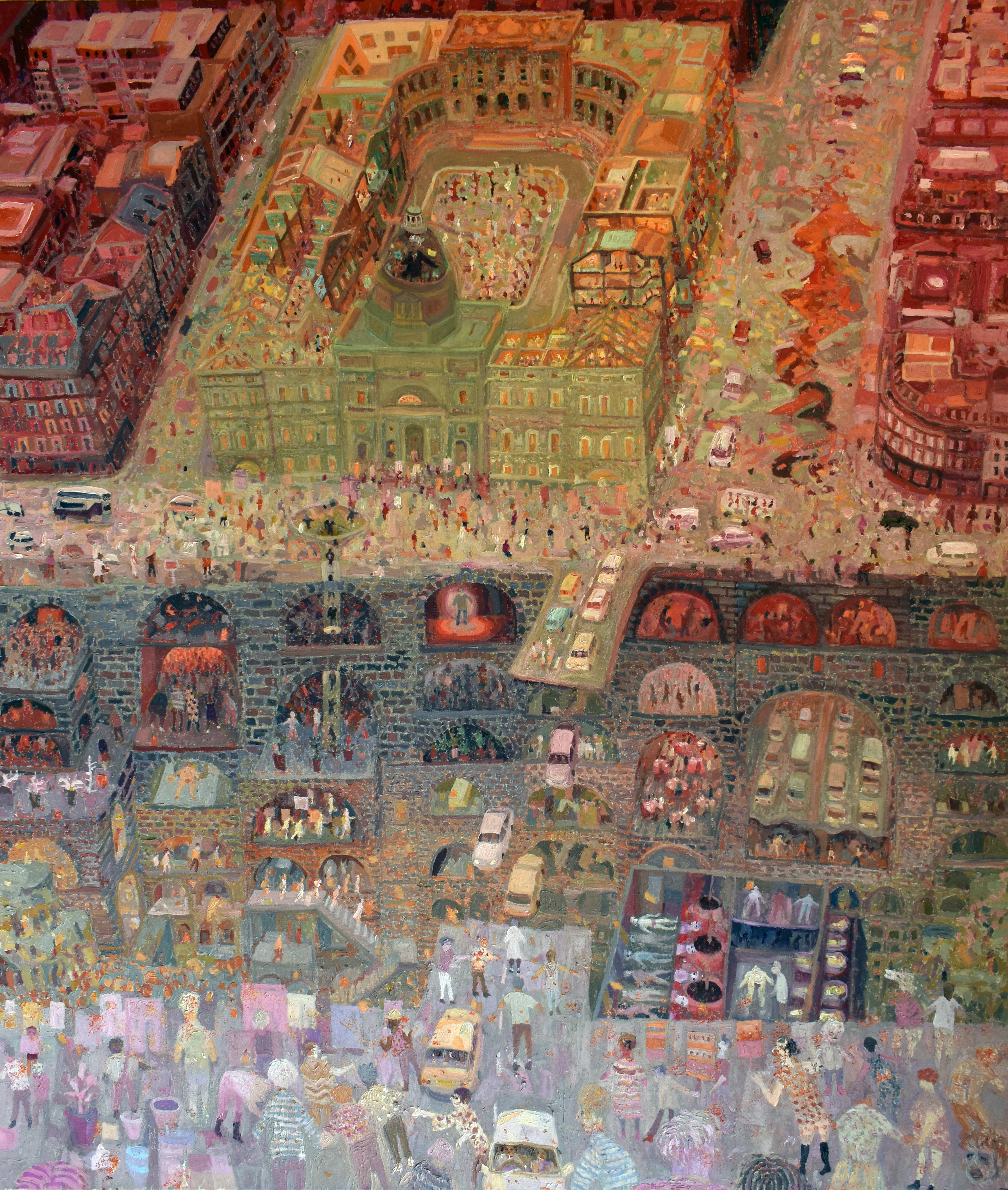
We’re sitting down with our Academicians to discuss their practices, influences and upcoming projects. Today, we’re speaking to Robbie Bushe RSA about childhood memories, the RSA Blackadder Houston Mid-Career Painting Award and Frontiers.
Your work centres on the depiction of detailed, suggestive narratives, often pulling inspiration from the places in which you’ve lived and worked. Having been born in Liverpool, grown up in Aberdeen and now living in Edinburgh, are there any standout locations that you find yourself being drawn back to at this point of your career?
I find inspiration in the places and spaces where I've lived. Particularly in the houses, buildings, interiors, and streets that have been the backdrop to my life experiences. I have vivid memories from my childhood of Tornaveen in Aberdeenshire, with its rural farmland, rolling hills, forests, challenging winter weather and short summers. My paintings serve as a way to capture the journeys I remember, such as bus routes and walks from my imaginative playgrounds during my early years. The characters I created and the stories I played out in my mind as a child often resurface in my painting. During my time as a student in Edinburgh, I lived in rented rooms in grand Georgian and Victorian flats, which provided the settings for my painted depictions of everyday life, capturing interiors, coffee mugs, lost loves, and excesses.
Currently, I'm using Edinburgh as a backdrop to explore and process the global issues of populism, climate crises, and international conflicts. My interest has shifted towards cities and their complex infrastructural histories, merging my fascination with epic movie themes such as Journey to the Center of the Earth, 20,000 Leagues Under the Sea and Ben Hur. I recently had the opportunity to revisit Liverpool, where I lived until the age of five, and surprisingly, I still feel connected to the streets and places from my early years. The art galleries and locations my parents took me to visit have had a profound and awakening impact on me.
Your father Fred Bushe was a sculptor and member of the Academy, your mother an art teacher and your brother is a painter. Could you tell us about what it was like to grow up surrounded by creativity, and the effect that had on your own work?
Both of my parents were artists, and they always encouraged my siblings and I to express ourselves. Our home was often filled with our parents' bohemian friends and colleagues, many of whom were artists and performers. At the time, it felt perfectly normal and not particularly glamorous. However, it could be embarrassing when my school friends discovered that my father created large abstract sculptures - especially the one displayed in Aberdeen Art Gallery, right next to my school. There wasn't much appreciation for contemporary art among my peers, and my own art teacher even raised an eyebrow at my father's work and his outspoken newspaper letters about sculpture and architecture. Our house was always bustling with parties and social events, which was exciting to be a part of. My dad was a member of the notorious 1970s 'Egyptologists' group, which consisted of a group of Aberdeen male artists and lecturers who gathered once a month. The wives were expected to host while the gentlemen discussed art, philosophy, and culture. All I can recall is that the next day, the house would be in disarray with glasses, bottles, overflowing ashtrays, and the remnants of buffet food. However, the greatest gift my father passed down to me was the appreciation for the ability to draw and express ideas through any medium, be it a pencil, crayon, or anything else. I will always be incredibly thankful for what he instilled in me.

Fred Bushe RSA, Both Sides of the Moon, granite. RSA Diploma Collection Deposit.
The cutaway is something you use often in your paintings, allowing the viewer to see though buildings and objects to view how things work. Are there any artists you’ve encountered over the years whose creative process you wish you could take a look inside of and investigate similarly?
As a lecturer, I often delve into artist’s processes. There is a wealth of information and imagery available on contemporary practitioners and artists that is not exactly obscure. Frank Soltesz, renowned for his cutaway illustrations in America between the 1930s and 1960s, captivated my imagination with his depictions of the inner workings of buildings such as factories and hospitals during my childhood. These illustrations have since become my primary inspiration for depicting a variety of activities within a single painting. I believe that Edward Hopper, in many of his works, attempted to simultaneously reveal the interior and exterior by employing window devices as a means to explore both dimensions.
If I were pressed to choose just a few artists whose inner workings and processes I'd like to understand better, I would have to mention Hernan Bas for his ability to blend complex elements while maintaining expressive and free-flowing paint passages. Similarly, I'm eager to gain further insight into Jules de Balincourt's seemingly effortless manipulation of scale changes and ability to uphold a painterly swagger.

Robbie Bushe RSA, People and Money, oil on canvas
We were delighted to announce back in November that you had received the inaugural £20,000 RSA Blackadder Houston Mid-Career Painting Award. What have you been working on since receiving the award?
I immediately began creating the large paintings for Frontiers, which portray sections of Princes Street in Edinburgh. These pieces imaginatively speculate what the area might look like today if the proposed upper walkways and underground roads from the 1960s had been built.
Currently, I’m focusing on a series of smaller paintings tentatively titled Multi-stories. These works delve into the inner life of individual rooms and their relationship to the surrounding buildings. Initially, my focus is on examining how people coexist within buildings, whether they are residential tenants, office workers, or retail employees. While this theme will certainly develop, I am also compelled to integrate my reflections on current events and global politics, and their impact on our local communities.

Robbie Bushe RSA, The Mound, oil on canvas.
Frontiers: Painting in Scotland Now, which was curated by yourself and Flora La Thangue, is currently on view in the gallery. Could you tell us a bit about the experience of putting the show together?
During my current career break, I had the opportunity to work on Frontiers, which has been really rewarding. Flora and I collaborated to create an exhibition celebrating contemporary Scottish painting from our unique perspective. The idea was too compelling to pass up, despite the potential challenges. We didn't follow an extensive research approach, nor did we base our selections on established criteria such as critical acclaim or commercial success. Instead, we simply chose artists whose work resonated with us and would contribute to a compelling exhibition. The inclusion of several Academicians and RSA New Contemporaries artists adds an academic angle to the exhibition. Surprisingly, curating Frontiers has been relatively stress-free compared to previous shows I've organised. The title has even sparked discussions on social media and among artists, evoking an intended sense of anticipation and excitement.
In your text for Frontiers, responding to the question ‘In a time when an artist can work in any media, why choose painting?’ you note that the act of painting has an intimacy you don’t find in other media. Do you think that’s why so many creatives continue to be drawn to the medium?
There's just something about painting; it’s elastic, it can crumble so quickly, and you can add paint and ruin it or save it in a second. In many other media, every action is reversible, but with painting there is no backspace or delete button. Painting often means taking things away, putting it back together and reconstructing, fixing colour choices, and struggling with paint surfaces getting a little dead. It has been interesting reading many of the Frontiers artists’ responses to the question ‘Why do you paint?’. Many speak of its immediacy and tactile qualities allowing infinite possibilities. I’ll leave it at that.
Hear more from Robbie Bushe RSA at our upcoming symposium, Other Worlds: A Conversation about Contemporary Paitning in Scotland.
Explore Robbie Bushe RSA's work further

